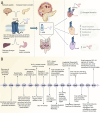GLP-1R in diabetes mellitus: from basic discovery to therapeutics development
- PMID: 40520185
- PMCID: PMC12162565
- DOI: 10.3389/fphar.2025.1610512
GLP-1R in diabetes mellitus: from basic discovery to therapeutics development
Abstract
Diabetes mellitus (DM), a metabolic disorder syndrome characterized by persistent hyperglycemia, has a complex pathogenesis. As the number of diabetic patients continues to grow globally, this disease has become a major and growing challenge in global public health. Glucagon-like peptide-1 receptor (GLP-1R) is a G protein-coupled receptor widely expressed on the surface of a wide range of cells in the human body, including pancreatic islet α, β and δ cells, as well as multiple tissues such as the intestines, stomach, lungs, heart, kidneys, and central nervous system. GLP-1R works through the combination of the endogenous ligand Glucagon-like peptide-1 (GLP-1) or exogenous agonists, which activate multiple intracellular signaling pathways that enhance insulin secretion, inhibit glucagon secretion, protect β-cells from apoptosis, delay gastric emptying and increase satiety. This makes GLP-1R a key target for diabetes treatment. This paper reviews the structural and functional characteristics of GLP-1R. Its role in glucose homeostasis and its application in diabetes treatment. It focuses on the mechanism of action of GLP-1R in pancreatic islet α-cells, β-cells and δ-cells, as well as its effects on the central nervous system and gastrointestinal tract. In addition, the article reviews the clinical progress of GLP-1R agonists, including their efficacy, safety and potential in the treatment of diabetes and related complications.
Keywords: blood glucose; diabetes mellitus; glucagon-like peptide-1 receptor; insulin secretion; β-cell.
Copyright © 2025 Li, Huang, Wang, Huang, Luo and Huang.
Conflict of interest statement
The authors declare that the research was conducted in the absence of any commercial or financial relationships that could be construed as a potential conflict of interest.
Figures

Similar articles
-
The value of short- and long-acting glucagon-like peptide-1 agonists in the management of type 2 diabetes mellitus: experience with exenatide.Curr Med Res Opin. 2016;32(1):61-76. doi: 10.1185/03007995.2015.1103214. Epub 2015 Nov 11. Curr Med Res Opin. 2016. PMID: 26439329 Review.
-
18F-Labeled exendin(9-39).2012 Feb 9 [updated 2012 May 17]. In: Molecular Imaging and Contrast Agent Database (MICAD) [Internet]. Bethesda (MD): National Center for Biotechnology Information (US); 2004–2013. 2012 Feb 9 [updated 2012 May 17]. In: Molecular Imaging and Contrast Agent Database (MICAD) [Internet]. Bethesda (MD): National Center for Biotechnology Information (US); 2004–2013. PMID: 22624171 Free Books & Documents. Review.
-
Do glucagon-like peptide-1 receptor (GLP-1R) agonists have potential as adjuncts in the treatment of type 1 diabetes?Expert Opin Pharmacother. 2018 Oct;19(15):1655-1661. doi: 10.1080/14656566.2018.1519547. Epub 2018 Sep 20. Expert Opin Pharmacother. 2018. PMID: 30234389 Review.
-
Positive Allosteric Modulation of the Glucagon-like Peptide-1 Receptor by Diverse Electrophiles.J Biol Chem. 2016 May 13;291(20):10700-15. doi: 10.1074/jbc.M115.696039. Epub 2016 Mar 14. J Biol Chem. 2016. PMID: 26975372 Free PMC article.
-
The glucagon-like peptide-1 receptor agonist oxyntomodulin enhances beta-cell function but does not inhibit gastric emptying in mice.Endocrinology. 2008 Nov;149(11):5670-8. doi: 10.1210/en.2008-0336. Epub 2008 Jul 31. Endocrinology. 2008. PMID: 18669601
Cited by
-
Efficacy and Safety of GLP-1 Receptor Agonists and SGLT-2 Inhibitors in the Treatment of Diabetes Mellitus and Obesity in Liver Transplant Recipients: A Systematic Review.J Clin Med. 2025 Jun 30;14(13):4619. doi: 10.3390/jcm14134619. J Clin Med. 2025. PMID: 40648992 Free PMC article. Review.
References
-
- Ahmann A. J., Capehorn M., Charpentier G., Dotta F., Henkel E., Lingvay I., et al. (2018). Efficacy and safety of once-weekly semaglutide versus exenatide ER in subjects with type 2 diabetes (SUSTAIN 3): A 56-Week, Open-Label, Randomized Clinical Trial. Diabetes Care 41, 258–266. 10.2337/dc17-0417 - DOI - PubMed
Publication types
LinkOut - more resources
Full Text Sources
Research Materials

